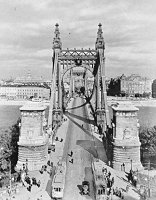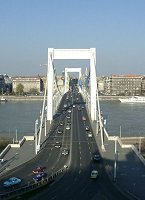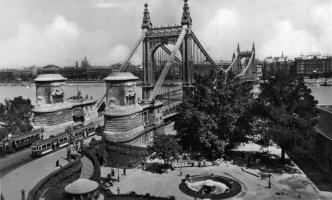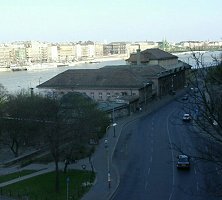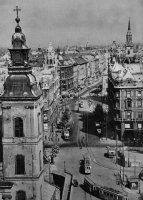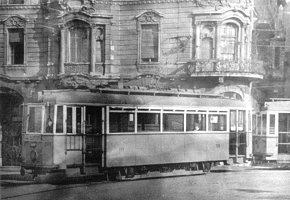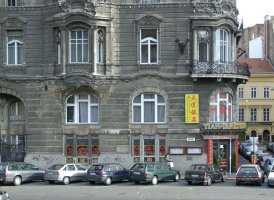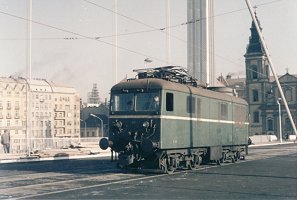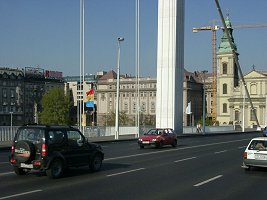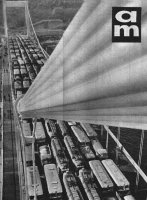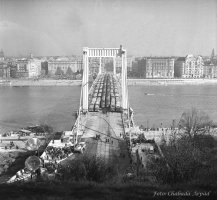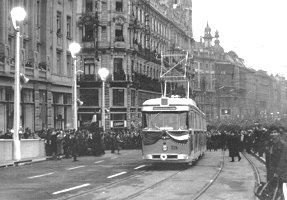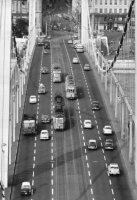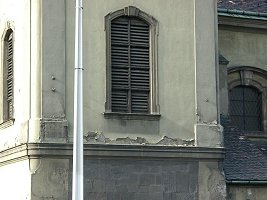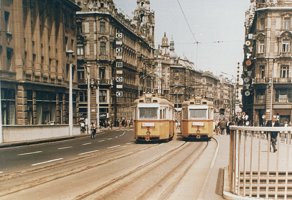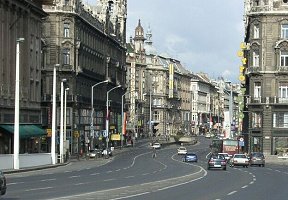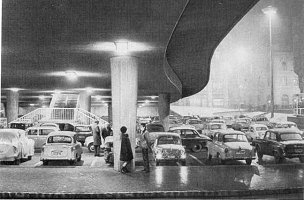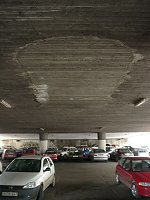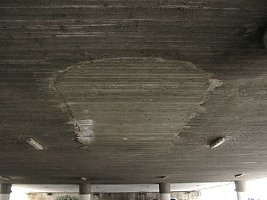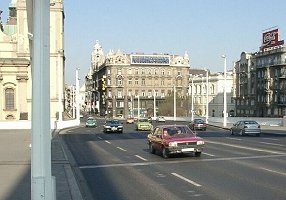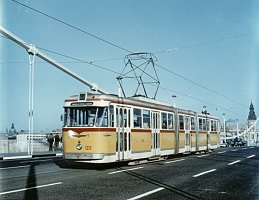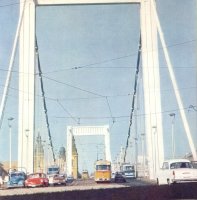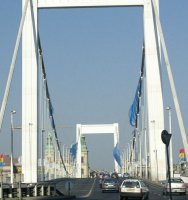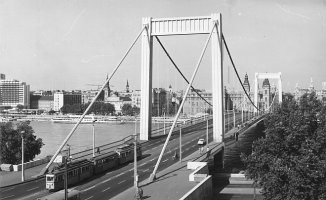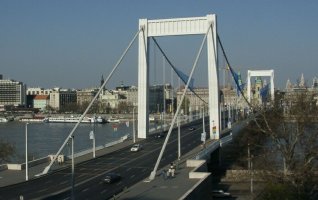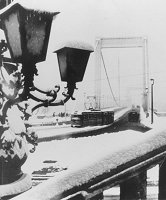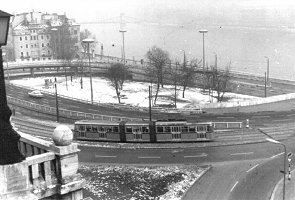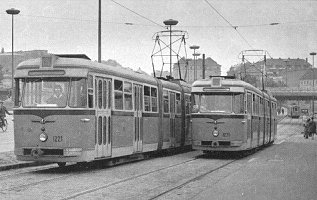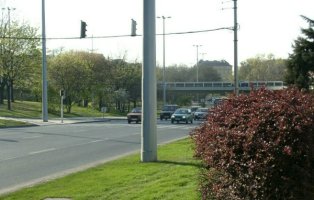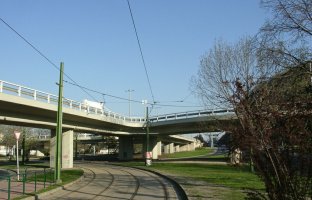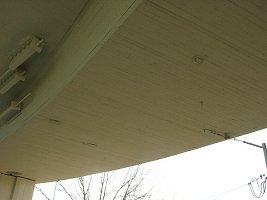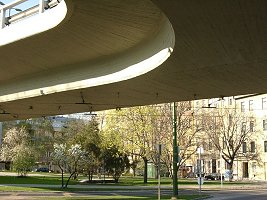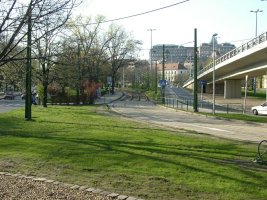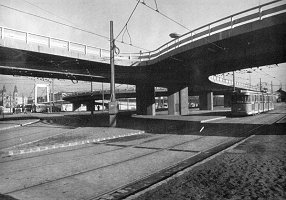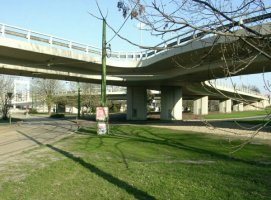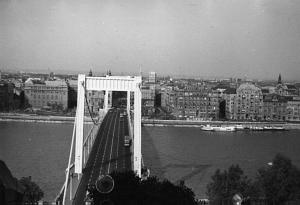budapest
other hungarian
close-up
lost rails
other countries
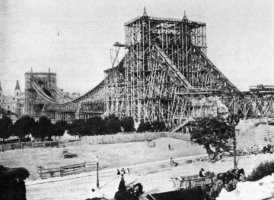 Erzsébet
híd is one of the most prominent symbols of modern Budapest, but of
course the cable-bridge you can see today is not the first here. And,
even if the army of the roman empire used this place to cross the river
Danube, the bridge does not have the long history you would expect. At
the end of the 19th century the banks of the river were not build out
as they are now: the whole neighborhood was used as one long wharf. On
the Buda side lay Tabán, polulated mostly by serbs, on the
Pest side there wasn't even a road leading to where the bridge
would later emerge. The old City Hall used to stand where now Március
15 tér is, its big building with a tower on top (still in the city's
crest and ensign even today) closed down the inner city: the riverside
was just the city limits before Buda and Pest were united
into Budapest (1873). The city authorities have felt that this
wasn't right and started to re-think most of the city. In the case of
this place this involved knocking down the old City Hall and a few other
buildings too, to make room for a well-engineered and modern city. And
a modern city needs bridges. Magnificent ones, too!
Erzsébet
híd is one of the most prominent symbols of modern Budapest, but of
course the cable-bridge you can see today is not the first here. And,
even if the army of the roman empire used this place to cross the river
Danube, the bridge does not have the long history you would expect. At
the end of the 19th century the banks of the river were not build out
as they are now: the whole neighborhood was used as one long wharf. On
the Buda side lay Tabán, polulated mostly by serbs, on the
Pest side there wasn't even a road leading to where the bridge
would later emerge. The old City Hall used to stand where now Március
15 tér is, its big building with a tower on top (still in the city's
crest and ensign even today) closed down the inner city: the riverside
was just the city limits before Buda and Pest were united
into Budapest (1873). The city authorities have felt that this
wasn't right and started to re-think most of the city. In the case of
this place this involved knocking down the old City Hall and a few other
buildings too, to make room for a well-engineered and modern city. And
a modern city needs bridges. Magnificent ones, too!
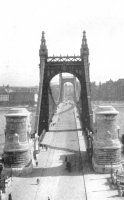 They
decided to build two bridges at the southern and northern end of Gellért
hegy which dominated the Buda side of the river. One of the
bridges begot the fragile cantilever-bridge Szabadság híd, the
other "the bridge at Eskü tér": a richly ornamented chain-bridge
with the widest span of the time among its type. Construction works on
the latter started in 1897 and 6 years later it was ready. Upon its opening
it was named after Queen Elisabeth, or "Sissi", the late wife of austro-hungarian
emperor Franz Joseph vom Habsburg, who was killed by an italian anarchist
in 1898. The bridge was considered as one of the most marvellous at the
time.
They
decided to build two bridges at the southern and northern end of Gellért
hegy which dominated the Buda side of the river. One of the
bridges begot the fragile cantilever-bridge Szabadság híd, the
other "the bridge at Eskü tér": a richly ornamented chain-bridge
with the widest span of the time among its type. Construction works on
the latter started in 1897 and 6 years later it was ready. Upon its opening
it was named after Queen Elisabeth, or "Sissi", the late wife of austro-hungarian
emperor Franz Joseph vom Habsburg, who was killed by an italian anarchist
in 1898. The bridge was considered as one of the most marvellous at the
time.
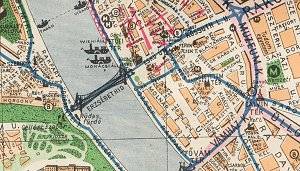 It
was opened, but there was still something strange about it: there were
rails on the road, but they ended before the bridgheads - just take a
look at the picture to the right, you can spot this anomaly! This was
due to a struggle between the two tram companies, BVVV and BKVT for this
corridor to the other side of the river: both wanted to get the concession
for this route, but they both were unable to meet the requirements the
city council demanded in return for the license. This drag continued until
1914 when they decided that BKVT would own the route, but BVVV may also
make use of the bridge. Upon the decision BKVT extended its Rákóczi
(then Kerepesi) út routes to Buda through Kossuth Lajos
utca and Erzsébet híd, while BVVV layed tracks in Veres
Pálné utca to reach the bridge, and then launched its first and only
route to Buda, which ended at Tabán, just a few hundred meters
from the bridge.
It
was opened, but there was still something strange about it: there were
rails on the road, but they ended before the bridgheads - just take a
look at the picture to the right, you can spot this anomaly! This was
due to a struggle between the two tram companies, BVVV and BKVT for this
corridor to the other side of the river: both wanted to get the concession
for this route, but they both were unable to meet the requirements the
city council demanded in return for the license. This drag continued until
1914 when they decided that BKVT would own the route, but BVVV may also
make use of the bridge. Upon the decision BKVT extended its Rákóczi
(then Kerepesi) út routes to Buda through Kossuth Lajos
utca and Erzsébet híd, while BVVV layed tracks in Veres
Pálné utca to reach the bridge, and then launched its first and only
route to Buda, which ended at Tabán, just a few hundred meters
from the bridge.
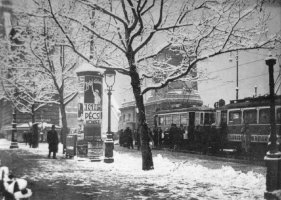 This
of course did not form one unite network until joint transportation company
BSZKRT was formed in 1923. Things weren't really nice then (the country
has just lost World War I, plus two third of its territories), but at
least public transportation was getting more organised. In 1928 there
were 8 routes using the bridge:
This
of course did not form one unite network until joint transportation company
BSZKRT was formed in 1923. Things weren't really nice then (the country
has just lost World War I, plus two third of its territories), but at
least public transportation was getting more organised. In 1928 there
were 8 routes using the bridge:
14 (Orczy tér - János kórház (St. John's Hospital))
17-es (Bosnyák tér - Gellért tér)
18-as (Városliget (City Park) - Déli pu. (Southern railway
station))
19-es (Keleti pu. (Eastern railway station) - Kelenföld
railway station)
44-es (Budapest Zoo - Szépilona)
53-as (Orczy tér - Óbuda, Fő tér)
75-ös (Keleti pu. (Eastern railway station) - Csörsz utca)
76-os (Keleti pu. (Eastern railway station) - Déli pu. (Southern
railway station))
This was way too much, the trams were queuing from stop to stop, and there
was a great mess when one of them would broke down, so in 1930 the routes
were rationalized: only five left.
Now, before with get on with history, let's take a glance at the past and what's left of it:
The old and the new Erzsébet híd: the new was intended as a modernized and cleaned-up version of the old.
Traffic on the bridge in the 1930's and 40's. Notice the "keep to the left" orientation! On the picture to the right you can also see a few "Stukas" (3600-series, predecessor of the UV).
Left: a mid-entance Ganz multiple unit of the company BLVV. This must have been a test ride - this type was not used in the inner city traffic those days! Right: the almost idillyc panorama of the bridge in the 30's.
Although the picture to the left was taken later (in the fifties or early sixties), it shows that the tracks did not go under the bridge then as they do now (route 18 and 19), but went up before the bridghead, and crossed the traffic of the bridge.
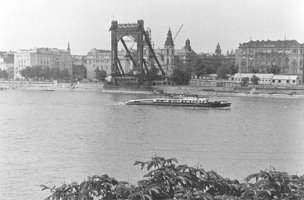
The lovely chain-bridge we saw on previous pictures was blown up by retreating
german troups in 1944. With this, one of the main through routes of the
city was broken in two: all the other bridges were rebuilt by the early
fifties, but Erzsébet híd was left in ruins. As you can see above,
the Pest leg was left quite intact, while the one on the other side of
the river collapsed after the explosion. The remaining pillar was even
strengthened so that it would stay upright - this was a sad symbol for
destruction for almost two decades! The traffic was detoured to the other
bridges, especially Szabadság híd.
The reason they didn't torn down the remaining pillar is because originally it was planned that the bridge should be rebuilt to its original form. This however changed in 1960, when they decided that a new, modern bridge should be built on the foundation of the old. Dr. Pál Sávoly was entrusted to design the new Erzsébet híd, and he did this using the piers and the main measures of the old bridge. The result was a delicate cable-bridge which looked like a reincarnation of the old idea with new techniques. Most of us here in Budapest love this bridge, because it blends into the city panorama without any aggressive "modern-ness".
But again: let's not rush: we're just after the war, the new bridge is still not there. With Kossuth Lajos utca (the street that leads to the bridge) being cut off from the Buda side, tram traffic was detoured to Szabadság híd: Small Boulevard became the main traffic route of the city. Car traffic was almost non-existing (only military and state usage was allowed - there were no private car owners), so it was necessary to redesign the public traffic network. In 1947 they built a turning loop at the Pest bridgehead for the trams on Rákóczi út, which were served by motor+trailer sets. You can see parts of that loop on the pictures above.
When the construction works for the new bridge started in the early sixties, the tram terminus was moved to Ferenciek tere (then Felszabadulás tér). The new place was narrow - no room for a loop, so a "delta" (or "Y") track was built at Veress Pálné utca. There was also a time when the metro underpass was built at Astoria, during these months the trams used a stub-end terminus on Rákóczi út, near Puskin utca.
It wasn't a streight deal whether trams would go on the new bridge or not: according early plans, subway line M2 should have been ready before the new Erzsébet híd, so they thought there would be no need for tracks on the bridge. However, by the end of the fifties it was clear that the underground line will not be ready in time. What now? They altered the plans, and put temporary tram tracks onto the bridge. "Temporary" means that it was not built out properly, that is the way a track on a cable-bridge is supposed to. It was more of a patch, and this was bad, because some of the trams riding on these tracks later were damaging the whole bridge because of the unproper tracks! The city authorities must have been thinking that with the new subway line there would be no need for trams here, and the patch would work for the years until then...
On the picture to the left you can see a HÉV (suburban train) diesel loco doing a test ride on the almost full-blown Erzsébet híd. Before you ask: the current collector on top of the loco is there only for the heating.
And the big day: the public endurance test of the new bridge with UV tram sets, Ikarus buses and lorries carrying sand sacks. "Public test" means that on the night before there was a "non-public" test, too, involving HÉV locos and lorries. The test was done successfully: the acquired data about movements (traversing, shuffling, etc) matched the expected (for example the middle of the bridge inclined by about 90 centimeters downwards without unneccessary vibrations).
The opening of the Erzsébet híd symbolised that the country has overcome the destructions of the war. The first vehicles crossing the Danube here were "home-made" articulated tram FVV-1228 and an articulated bus built by the Budapest bus company FAÜ (in those days tram, bus and HÉV were operated by different companies). This reflects a tendency: almost everything was articulated then, they even built an articulated UV car to experiment with this technology!
Four tram lines used the new bridge around then:
19 (Kelenföld railway station - Keleti railway station),
44 (Moszkva tér - Rákospatak),
60 (Csörsz utca - Keleti railway station)
68 (Móricz Zsigmond körtér - Örs vezér tere)
A few months later line 67 was also extended to Buda, to Szarvas tér,
and there were also the intermittent services 44A and 60A. As for vehicle
types: a colorful mixture of mid-entrance cars, cars of the 1500-series
(with trailers), the "home-made"
Bengali, UV and Ganz
articulated could have been seen here.
The stop at Március 15 tér (the Pest bridgehead) had an underpass...
... of which the location of the stairs can still be seen.
The stop seen from above.
A UV and a Ganz articulated at Március 15 tér.
10-door "home-made" heading for Pest.
To the left: peak-hour traffic around 1970. To the right: low traffic in 2002.
I don't think this picture needs an explanation...
Wintertime...
The stop at the Buda bridgehead (Döbrentei tér) laid in accent, so the conductor had to apply the brakes in the back car of UV trains stopping here, otherwise the set would slowly slide down the slope. This was a clear sign that the brakes of the UV needed some strengthening...
As opposite to the way trams have passed by the Buda bridgehead of the old Erzsébet híd, now they went by under the bridge, so trams coming to and from the bridge did not cross car traffic. There was a three-way track connection here, from which only one direction left: this is where route 18 (Savoya Park - Albertfalva kitérő) is going now.
You can still guess where the tracks and overhead wire went...
Another picture of the three-way junction.
UV set on the bridge. The quiet gloom of this picture refers to the sad fact that in the last days of 1972 all tram traffic on Rákóczi út and Erzsébet híd was stopped, because by then subway line M2 (Déli railway station - Örs vezér tere) was completed: one part of it was opened in 1970, but it got to Buda only in 1972. The auhorities at the time were against any kind of paralellism between underground and other public transport means, so they abandoned the trams here even against public outcry. In the 30 years that passed by since that it became obvious that this was a bad decision: Rákóczi út is now anything but a nice place, and surely not worthy to its past, with all the persistent traffic jams and the air and noise pollution of the present that harms the buildings and the people who live in them as well!
The tracks were left on the bridge for a few months: they just filled the rails with pitch to hide the gaps. After that the rails were removed, however, on the picture above (taken by my parents in 1973) you can still make out the parallel lines where the rails were. Too bad that no politician wants to take the heavy task of rebuilding the tram line here now, and so, the whole thing remains just a memory...
Archive
photos and maps from the collections of Zoltán Ádám Németh, "Mr.
Cyber" and Ákos Endre Varga
Present photos:
Ákos Endre Varga
Back to the top Back to the main page
